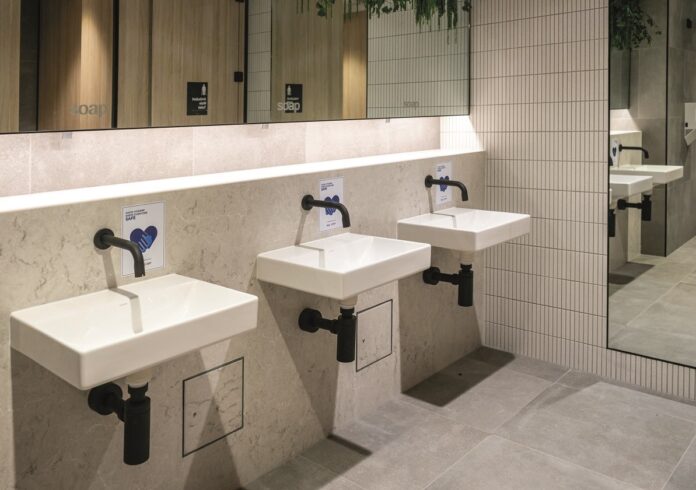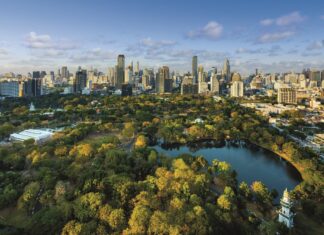A research project in Australia has been looking at how smart tech devices can deliver solutions to help manage and reduce water usage. Cameron Bayley explains.
As smart TVs, smart refrigerators and other intuitive Internet of Things appliances pop up around homes, the bathroom is the next frontier. But what sort of impact could these devices have, especially on water usage? That’s the question behind the ‘Bathrooms of the Future’ research programme carried out by the Institute of Sustainable Futures (ISF) at the University of Technology Sydney (UTS), in partnership with Sydney Water and GWA Caroma, an Australian bathroom fixture company that focuses on water conservation.
“This technology has lots of potential for saving water, understanding how people use water in different environments, as well as many other insights,” says ISF programme manager and research consultant Alexandra Butler.
“It’s not just a technology question,” adds data analyst Yohan Kim, research principal. “It’s about asking bigger questions on integration, governance and standardisation.”
Office observation
The first of the three streams of the project involved gathering data from smart bathroom technologies installed in a commercial building. The team placed a suite of devices into an office block in Rhodes, in Sydney, Australia, in 2021. Data was gathered from January to September 2022 and the analysis was finalised in April 2023.
The Caroma smart command environment was the focus of the pilot study of the first stream and provided inspiration for emerging bathroom smart water technologies. This technology is based on an integrated suite of smart devices, communication components and software. The devices are all installed with a Bluetooth module that enables remote configuration of the system.
Each of the devices is enabled with a sanitation activation option, which enables a hygiene flush of the fixture at regular intervals as set by the user. They are mains-connected and equipped with a backup battery to maintain functionality during a potential mains failure. These devices do not include meters recording water usage, but estimate consumption based on the number of activations.
When installed in a smart command ecosystem, the devices can report on water consumption and device activation, and enable real-time control of device settings. Devices include a urinal system, an electronic shower system with feedback monitor, washbasin taps, a control valve with leak detection and shut-off capabilities, a toilet, and a gateway communication component.
During streams two and three of the project, the team scanned emerging smart water technologies that might be prevalent in homes, buildings and communities beyond the bathroom. ISF reviewed more than 300 technologies on the market and under development.
Even though working from home orders during the COVID pandemic interrupted the team’s observations, over the course of two years they were still able to get insights into patterns of water usage in commercial buildings and how factors such as targeted messaging can influence behaviours – for example, signage educating users about the toilet’s half-flush option.
Forecasting future issues
Working in conjunction with Sydney Water, the second stream, with workshops held across 2021 and a field guide finalised in October 2021, looked at conceptualising where smart bathroom technology could take us in the future, looking at where we may be in a decade’s time, and how those ideas inform what needs to be done now.
Future concerns included possible privacy considerations around data gathered from household devices, increased electronic waste that could emerge, and the feasibility of different household appliances being able to complement and integrate with one another to provide a holistic understanding of the entire dwelling when it comes to water and energy consumption.
A forum for ideas
The final and major stream of the project was a forum held in March of this year. This gathered representatives from not only Sydney Water, GWA Caroma and UTS, but also other tertiary institutions, such as Western Sydney University, Macquarie University and Deakin University, along with relevant industry enterprises, such as the NSW Smart Sensing Network, BMT environmental consultants, and the Water Conservancy.
Butler explains: “The forum was about asking what questions the wider industry has and what ways technology can be used to address the challenges that we’re facing, looking at the next steps for research and what partnerships can develop.”
Over two days, the forum took a snapshot of the current situation with regards to smart technology, and the present challenges and barriers to its uptake.
The focus on the first day was looking at three areas of water usage: building and facilities management, water utility management, and community engagement.
The second day of the forum looked at the potential of smart water technologies and conceived several areas for future investigation and collaboration.
One consideration was the optimisation of smart taps to ensure that they are efficient without compromising on health compliance, and asking how machine learning could play a role in this.
Another topic of discussion was how a network of smart-tech devices could be used to streamline responses to leakage using analytics from each device and smart meter data to pinpoint leaks remotely. The third area discussed was the role of data analysis sourced from the technology to assist in the management of water supply during peak supply periods.
Call for standardisation
Throughout the project, it became clear that governance and standardisation across utilities needs to be established sooner rather than later. Butler says: “If data reporting is to grow as technology uptake increases, it’s an issue that needs tackling now. You can imagine the hurdle of suddenly realising down the track that it could be too late to merge this data. We don’t want to get to that point.”
Important partnerships
Kim and Butler emphasise the value of partnering with both Sydney Water and Caroma for the project.
“When it comes to Sydney Water, the impact of this technology when installed in more buildings is enormous,” says Kim. “It’s going to have a huge implication for water consumption at city level. So they want to step in early and help us to shape thinking on how we can use this technology when installations accumulate.”
“The opportunities for utilities like Sydney Water from smart technology are increasing all the time,” says programme partner Andre Boerema, who is programme manager (drought) and water efficiency expert for Sydney Water. “Traditionally, we’d get data back on a quarterly basis from water meters. Now, with digital metering, we’re able to get data much more quickly and we’re able to model demand to a much higher resolution than has ever been possible in the past.”
Working with Caroma was invaluable. With its smart technology now rolling out to around 250 buildings across Australia, the company shares the project team’s focus on the benefit to building managers, as well as in the wider context of sustainability. “By integrating AI into our smart systems, we’ll be moving to carbon neutral buildings, and I can see that this technology is going to help in doing that significantly,” says programme partner Dr Steve Cummings, innovation director at GWA Caroma.
The future is here
The instalment of smart devices is already happening at commercial level and it’s only a matter of time until it makes its way into the domestic sphere. The team hopes to continue investigating this area, as it has great potential to impact the community in meaningful ways. While water efficiency is the team’s focus, Butler says the project has opened the potential for many other areas as well, stating: “We’ve started thinking about the health benefits of having this technology in care homes and how it could be used to improve irrigation in open spaces during droughts. There are so many aspects where this smart technology could bring benefits.” •
The author
Cameron Bayley is a journalist working on behalf of UTS-ISF.
The research team
ISF’s Bathrooms of the Future research team are Dr Simon Fane (programme director, associate professor), Alexandra Butler (programme manager, research consultant), Dr Yohan Kim (stream one and three research principal), Dr Rachael Wakefield-Rann (stream two senior research consultant), and Judith Zhu (stream three research assistant).








